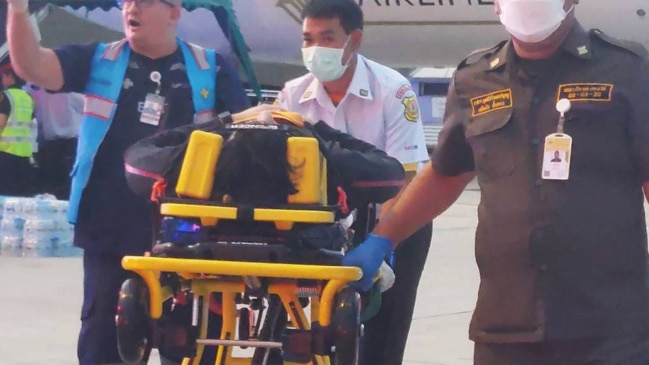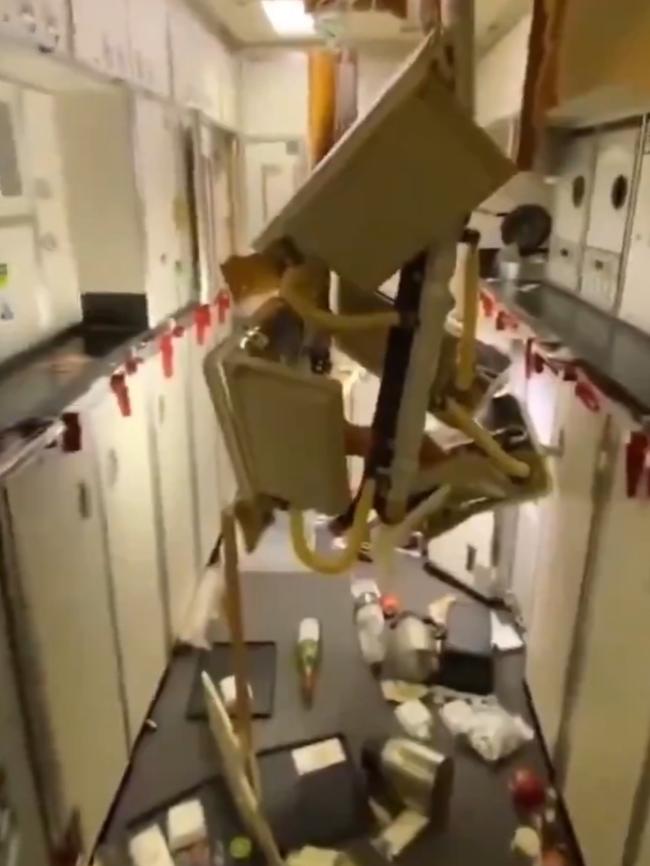Investigators’ early findings reveal what happened in Singapore Airlines turbulence disaster
Investigators have revealed their early findings on what happened during the Singapore Airlines turbulence disaster.

National
Don't miss out on the headlines from National. Followed categories will be added to My News.
The Singapore Airlines flight that suffered extreme turbulence, resulting in one death and many injuries, dropped 54 metres in less than five seconds.
That is according to preliminary findings from the Transport Safety Investigation Bureau of Singapore.
Flight SQ321 from London to Singapore had 211 passengers, including 56 Australians, and 18 crew on board last week when the nightmare unfolded over the south of Myanmar.
The pilot declared a medical emergency and diverted the Boeing 777-300ER to Bangkok, Thailand.
British man Geoff Kitchen, 73, died from a suspected heart attack, while others suffered skull, brain and spine injuries.
There are 26 passengers from the flight still in hospital in Bangkok, the airline said on Wednesday.


What the investigation has revealed so far
The team investigating the disaster includes Singapore’s Transport Safety Investigation Bureau, the US National Transportation Safety Board, US Federal Aviation Administration, and Boeing.
While investigations are still ongoing, Singapore’s transport ministry revealed preliminary findings on Wednesday based on data taken from the plane’s flight data recorder and cockpit voice recorder.
It said the aircraft experienced a “rapid change” in gravitational force (g-force) as “vertical acceleration” decreased from positive 1.35G to negative 1.5G within 0.6 seconds.
This is “likely” what caused passengers who did not have their seat belt on to “become airborne”, it said.
Vertical acceleration again changed from negative 1.5G to positive 1.5G within 4.0 seconds and “this likely resulted in the occupants who were airborne to fall back down”.
The preliminary findings showed the rapid changes in G over the 4.6 second duration resulted in an altitude drop of 54 metres (178 feet), from 37,362 feet to 37,184 feet.
“This sequence of events likely caused the injuries to the crew and passengers,” the statement said.


Prior to the sudden drop, the plane had initially experienced “slight vibration” and an “uncommanded increase in aircraft altitude” from 37,000 feet to 37,362 feet
The autopilot pitched the plane downward to its original altitude of 37,000 feet.
The pilots also observed an “uncommanded increase in airspeed” which they slowed by extending the speed brakes.
“While managing the airspeed … it was heard that a pilot called out that the fasten seat belt sign had been switched on,” the statement said.
The “uncommanded” increases in altitude and airspeed were most likely caused by an “updraft”, or the upward movement of air, it said.
The aircraft then experienced the rapid change in G, as described above.
About 17 minutes after the turbulence event, the statement said the pilots initiated “a normal, controlled descent” from 37,000 feet and in just over three minutes the plane descended to 31,000 feet.
“The data showed that the aircraft did not encounter further severe turbulence during this diversion,” it said.
This 6000 feet descent seen on flight tracking data was previously assumed to be the “sudden drop” that caused the injuries.
How turbulence come out of nowhere
When flying over the south of Myanmar, where the sudden extreme turbulence hit, the plane was “likely flying over an area of developing convective activity,” the ministry said.
Experts told news.com.au the area is a known for turbulence. It is called the Intertropical Convergence Zone, an area near the equator, where thunderstorms are very common.
“The warmest oceans in the world occur around Asia and so the heat transfer into the atmosphere from the surface of the ocean is larger in Asia than it is everywhere else,” Emeritus Professor Jason Middleton, who was head of the UNSW School Of Aviation from 1995 to 2017, said last week.
“Hot air rises and so that’s why you get cloud towers in the tropics with the hot moist air rising.”
He said high clouds can happen at any time of day in the area.
“The cloud tops are over 40,000 feet in that area, typically, and can be even at night,” he said.
Em Prof Middleton said the reality was that aircraft do not have a turbulence monitor, and it is why he only ever takes his seat belt off to go the aircraft lavatory.
“The [weather] radar doesn’t show turbulence, the radar only shows rainfall, it only shows water droplets,” he said.
He explained that when pilots see patches of heavy rain and thunderstorms showing up on the radar, they will avoid it, however, areas showing up clear on the radar do not necessarily have no clouds or turbulence there – there are just no water droplets big enough to be detected.
Todd Lane, an atmospheric science professor at Melbourne University, added that “thunderstorms can generate turbulence from up to 100km away from the storm.”
“So you can be quite a significant distance away from a thunderstorm but it still generates some turbulence and this is often a cause of these types of unexpected encounters where the aircraft is a long way away from a thunderstorm, the air is smooth, the seatbelt sign is not on and then you might hit a small patch of unexpected turbulence,” he said.
– with AFP
More Coverage
Originally published as Investigators’ early findings reveal what happened in Singapore Airlines turbulence disaster





